Spreadsheet
Spreadsheets are used to work with financial information. Spreadsheets are laid out in numbered rows and lettered columns. Where the row and column intersect is called a cell. The cell is referred to by the letter and number of the intersection called the cell address. The first cell in a chart is at the intersection of column A and row 1 and is referred to as Cell A1.
Both commercial and Open Source spreadsheets are available. Tax and accounting software are also spreadsheets but are designed to provide tools and utilities which help get the specific job done.
| A | B | C | |
|---|---|---|---|
| 1 | |||
| 2 | |||
| 3 |
When working with numbers in a spreadsheet, refer to the cell addresses when creating mathematical formulas. This way any changes you make will be automatically updated without having to update the sheet.
Use the plus sign (+) to add; the minus (-) sign to subtract; the asterix (*) to multiply; and the back slash (/) to divide.
Spreadsheets use formulas to create simple to complex mathematical equations. A sheet can be built to handle the financial needs of businesses.
Most of the standard editing features are available in the spreadsheet such as Bold, Italics, Underline, Move, Copy and Paste.
Information from a spreadsheet can be displayed in a chart.
Most spreadsheet programs include templates to handle many of the average financial needs of a home user or small business. These templates can be modified or customized to personalize them for your own needs.
Most spreadsheet programs allow users to work on many sheets at once and access information from any of the sheets in the workbook group.
Last updated: February 12, 2021
